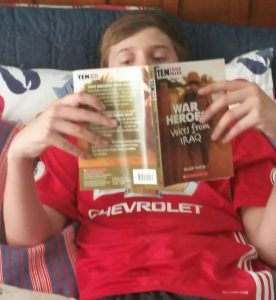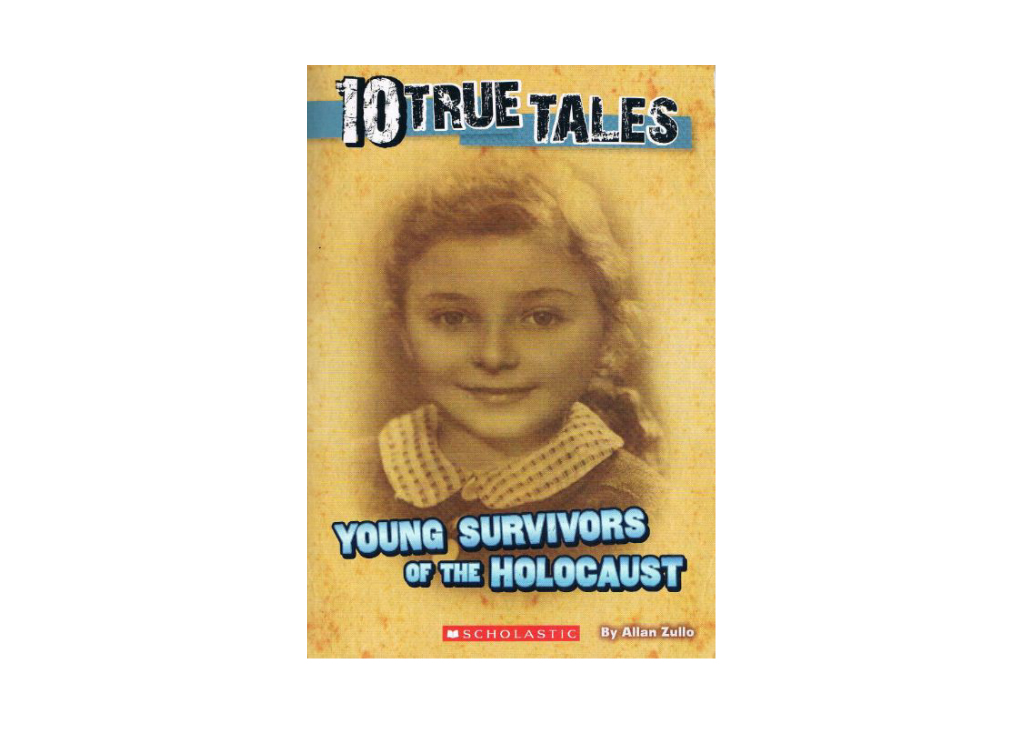This book showcases ten incredible true stories of remarkable boys and girls who survived the Holocaust. Their experiences are horrifying because that’s the way they really happened. It’s hard to imagine that anyone, especially children, could bear so much suffering from so much cruelty.
These accounts are based exclusively on personal, lengthy interviews with each survivor. Using real names, dates and places, the stories are written as factual and truthful versions of the survivors’ recollections.
 Among the stories in this book, you will read about a teenage boy who survived a botched escape attempt that killed his sister and then lived through a horrid, winter death march by eating rotting leaves… a girl who faced the notorious Joseph Mengele — known as The Angel of Death — and talked her way out of being exterminated… a boy who climbed out of a window of a locked fifth-floor room of condemned Jews and crawled across a wooden plank to another building while Nazi guards below were shooting at him… a brother and sister who slipped past Nazi guards and escaped a ghetto by hiding in an empty water barrel on a horse-drawn wagon… a boy who took on the identity of a non-Jew and faked out his Nazi interrogators… two young sisters who lived through the horrors of Auschwitz as slave laborers.
Among the stories in this book, you will read about a teenage boy who survived a botched escape attempt that killed his sister and then lived through a horrid, winter death march by eating rotting leaves… a girl who faced the notorious Joseph Mengele — known as The Angel of Death — and talked her way out of being exterminated… a boy who climbed out of a window of a locked fifth-floor room of condemned Jews and crawled across a wooden plank to another building while Nazi guards below were shooting at him… a brother and sister who slipped past Nazi guards and escaped a ghetto by hiding in an empty water barrel on a horse-drawn wagon… a boy who took on the identity of a non-Jew and faked out his Nazi interrogators… two young sisters who lived through the horrors of Auschwitz as slave laborers.
Each of the book’s extraordinary and inspiring stories will help you understand how important it is to keep recalling the past… so no one every forgets.
Any teacher who has a Scholastic account can order books for you on scholastic.com or by calling 800-SCHOLASTIC and asking for item number 978-0-545-90975-4.
THE HOLOCAUST
Led by dictator Adolf Hitler, the Nazi Party in Germany in the 1930s and ’40s believed that certain people — particularly Jews, Gypsies, homosexuals and the disabled — were inferior and didn’t deserve to live.
The Nazis were anti-Semitic, which means they hated the Jews. Although many Jews were doctors, lawyers, businessmen, bankers and teachers who contributed a great deal to German society, Hitler blamed them for Germany’s economic problems. The truth was that Germany was going through a difficult time economically because it was badly defeated in World War I, which ended in 1918.
Hitler and his parliament passed laws that required Jews to give up their jobs, homes, businesses and rights. To enforce these laws, the police organization known as the Gestapo and an elite army corps known as the SS imprisoned, beat and even murdered Jews — simply because they were Jewish. Non-Jews who opposed the Nazis’ authority suffered similar treatment. Many Jews and political enemies were sent to brutally run prisons known as concentration camps.
Hitler was determined to protect at all costs German blood and German honor for the country’s Aryans, the name given to white, non-Jewish Germans. He also was determined to invade and take control of all of Europe.
In March, 1938, Germany conquered Austria and enacted harsh new laws stripping Austrian Jews of their rights. Then in September 1939, German troops invaded Poland. This caused Great Britain and France, who were allies of Poland, to declare war on Germany, triggering World War II. The following year, Nazi forces invaded and occupied the European nations of Denmark, Norway, Belgium, Holland, and Luxembourg. Then France fell, and Great Britain was battered by German air assaults.
In December 1941, the United States entered the war and joined Russia, Great Britain and the Free French (an organization fighting for the liberation of France) to form the Allied Forces, which battled to stop the German war machine. Also fighting the Nazis in German-occupied territory were secret groups of brave citizens known as the Underground, the Resistance or the Partisans. They used sabotage against the German army and helped Jews escape. In addition, courageous non-Jews (known typically in the Jewish community as Righteous Gentiles) risked their lives to save Jews from the Nazis.
As country after country fell under German occupation, Jews were singled out for mistreatment and lost their rights. They had to wear the six-pointed Star of David, a symbol of Judaism, on their sleeves, chests or backs to distinguish them from non-Jews. They couldn’t walk freely in the streets or do many of the things Europeans took for granted. Signs in theaters, cafes, restaurants and other public places warned that Jews weren’t allowed to enter.
During the war years, the Nazis created ghettos — small, sealed areas inside cities where Jews were forced to live in unhealthy and crowded conditions. Every month, tens of thousands of Jews were deported to forced-labor camps, concentration camps and death camps, where, unless they were useful to the Nazis, they were killed in gas chambers or murdered in some other way. It was all part of Hitler’s Final Solution — the Nazi plan to eliminate all the Jews of Europe.
As the war came to an end in 1945, the Allies liberated the imprisoned Jews, although hundreds of thousands were barely alive because of Nazi cruelty. The world was shocked to discover that of the 9 million Jews who had lived in Europe before the war, 6 million had been murdered or had died from starvation or disease in Nazi camps. Another 4 million civilians, including 3 million Polish Catholics, died at the hands of the Nazis. Of the Jewish children who failed to escape Europe after 1939, more than a million and a half were murdered by the Nazis or were deported to camps where they died of illness or hunger. This horrific mass murder is called The Holocaust, a word from ancient Greece meaning sacrifice by fire.

